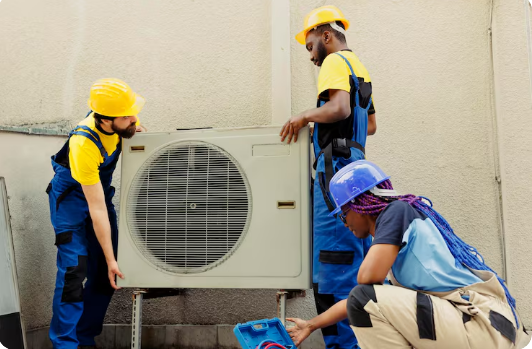When your central heating goes on the blink, it can be a real pain. The thermostat might be acting up, making your rooms too hot or freezing. Boilers can also throw a fit because they’re worn out or haven’t had a check-up in a while, sometimes stopping the heating altogether.
Then there are radiators, which can have blockages or air bubbles that make the house heat unevenly. If you get a handle on these common problems, you might be able to keep your heating running smoothly and stress-free.
Safety First
If your central heating’s acting up, safety comes first. Smell gas or hear weird noises? Switch it off straight away. These could mean a gas leak, which is really dangerous.
Best to leave the house and call in a pro to check things out. Don’t mess with any switches either, just to be safe. Always think about safety and let the experts handle tricky stuff like this.
Checking the Thermostat and Power Supply
If your central heating stops working, start by checking the thermostat. Make sure it’s set to the right temperature—maybe someone accidentally changed it or turned it off. If you’ve got a programmable one, check the schedule settings too.
Next, see if the system’s getting power. Peek at the circuit breakers in the electric panel; a tripped breaker might be the culprit. If any are off, just flip them back on. Have a look at the fuses too, and change any that are blown, as they could mess with your heating.
If these steps don’t fix things, take a look at your boiler’s manual for more tips. Doing these simple checks can save you time and might mean you don’t need to call a repair technician. But if nothing works, don’t hesitate to get professional help.
Bleeding Radiators for Even Heating
If your home’s heating feels a bit off, it might just be some air stuck in the radiators. This is pretty common and easy to fix.
Sometimes, air pockets stop the hot water from moving properly, leaving cool spots at the top. To fix it, you’ll need a radiator key. First, make sure the heating’s off and the radiators are cool. Pop the key into the little valve at the top of the radiator.
Turn it anticlockwise until you hear a hiss—that’s the air escaping. When water starts dribbling out, twist it back clockwise to close it. Doing this helps your radiators heat up evenly and might even save on those energy bills.
Try to bleed your radiators once or twice a year, especially if you’ve just refilled the system or moved into a new place. It keeps things running smoothly and your home cosy when it’s chilly.
Checking and Adjusting Boiler Pressure
Keeping your boiler pressure just right is crucial for maintaining a cosy home. Picture this: it’s a chilly day, and you’re all snuggled up inside.
The last thing you want is for your heating to conk out because the pressure’s off. Most boilers have a pressure gauge right on the front, like a friendly little meter showing you the current reading.
You’re aiming for it to be between 1 and 1.5 bars when everything’s quiet and the boiler isn’t running.
If the pressure drops too low, your boiler might not heat your home effectively. Worse, it might even decide to take a little break, leaving you in the cold. So, what’s the fix? First things first: safety.
Always turn off the boiler before you start tinkering. Then, look for the filling loop. It’s usually a silver hose with a tap or lever. Open it up to let some water flow in while you keep an eye on the gauge.
Once it hits the sweet spot, close the valve. Easy does it, though—too much pressure, and you’re asking for trouble.
Now, every boiler is a bit like a snowflake—no two are exactly the same. That’s why it’s a good idea to have a peek at your boiler’s manual.
It’s got all sorts of handy tips specific to your model. Following these guidelines not only ensures you’re doing things by the book but also keeps your heating system running smoothly.
A well-maintained boiler is an efficient one, and that means fewer repair bills and a longer lifespan for the system.
So, why not pop open that manual and give your boiler a quick check-up? Your home will thank you with warm, cosy evenings, and your wallet will appreciate the savings on potential repairs.
Regular Maintenance as a Preventive Measure
Taking care of your central heating system regularly is one of the smartest ways to avoid unexpected breakdowns and expensive repairs. Just like you’d book your car in for a check-up, having a qualified technician inspect your heating system once a year helps keep everything running in top condition.
Routine checks can actually save you money in the long run. When small issues are caught early, they’re easier—and cheaper—to fix before they turn into major problems. Plus, a well-maintained system runs more efficiently, which means it uses less energy and helps lower your bills. It also extends the life of your boiler and radiators, so you won’t have to replace them as quickly.
Getting a heating engineer to inspect your heating setup each year gives you peace of mind that everything’s working properly, especially when the colder months roll in.
Being proactive about maintenance not only boosts the safety and performance of your system, but it also ensures your home stays warm and comfortable all winter long.
Rather than waiting for something to go wrong, make regular maintenance part of your yearly routine—and enjoy the long-term comfort and savings that come with it.
Staying Warm Until Repairs Arrive
When the central heating suddenly decides to take a holiday, staying warm might seem like a tall order. But don’t fret, there are plenty of ways to keep toasty. First off, a space heater can be your best mate in these chilly times.
Just remember to place it on a stable, non-flammable surface. Keep it at least three feet away from curtains or furniture to avoid any mishaps. And, always switch it off when you leave the room. Safety first, right?
Now, let’s talk about layering up. It’s like giving your body a warm hug. Start with thermal underwear as your base layer—these are brilliant for trapping heat. Throw on a wool jumper, and don’t forget about thick socks to keep your toes nice and warm.
A hat indoors might feel a bit odd, but it’s a game-changer since a lot of heat escapes from your head.
To make sure the warmth stays put, focus on the rooms where you spend the most time. Close the doors to unused spaces, and you’ll keep the heat where you need it most.
Those pesky drafts? A rolled-up towel or a draft stopper at the bottom of doors can work wonders in keeping the chill at bay.
By taking these steps, you can stay comfortable and snug until your heating’s back on track. Give these tips a try, and you’ll be well-equipped to handle the cold with a smile.
Conclusion
Taking care of your central heating is super important. Don’t just wait for things to go wrong—jot down any issues so a tech can fix them fast. Think about getting a new, energy-saving system.
These are more reliable, break down less, and keep energy bills steady, which is great when it’s chilly outside. Being on top of things keeps your place warm and helps save the environment by using less energy.
So, by focusing on maintenance and upgrades, you can stay comfy and eco-friendly.














